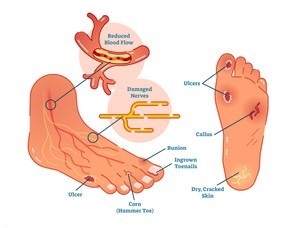| Catalog# | Product Name | Size | Price | Qty | Inquiry |
|---|---|---|---|---|---|
| THP-0292 | Trafermin, Recombinant human basic fibroblast growth factor | 15ug | $198.00 |
|
Add to Cart Order |
| 1mg | $1,798.00 |
|
Add to Cart Order | ||
| 5mg | $3,998.00 |
|
Add to Cart Order | ||
| THP-0303 | Nepidermin, Recombinant human epidermal growth factor (rhEGF) | 1 vial | $3,998.00 |
|
Add to Cart Order |
Diabetes is a major chronic disease that requires attention. Diabetic foot ulcers are a common and serious complication of type 1 and type 2 diabetes. Between 19% and 34% of all people with diabetes will develop a foot ulcer at some time in their lives. Patients with diabetic foot ulcers often underestimate the impact of the ulcers or even fail to recognize them. However, these ulcers can lead to a variety of complications, such as infections that require hospitalization and, in the most severe cases, even amputation, which can have a significant negative impact on a patient's life.

The management of diabetic foot ulcers remains a major therapeutic challenge. Platelet-derived growth factor-β (PDGF-β) has been developed to treat local therapy ulcers in uninfected diabetic feet. In addition to this, recombinant human basic fibroblast growth factor (rhbFGF) and recombinant human epidermal growth factor (rhEGF) are also considered to be promising adjunctive therapies.
With the intensive study of the wound healing process in recent years, researchers have found that many growth factors are closely associated with repair cells and play a key role in wound repair in particular. Fibroblast growth factor (FGF) is one of them. FGF-2 is also known as the basic fibroblast growth factor (bFGF). rhbFGF is a recombinant form of bFGF. bFGF is one of the most widely studied FGFs. In recent years, several studies have shown that bFGF does have a positive effect on the healing of diabetic ulcers.
Expression of bFGF in angiogenesis, neurogenesis, and neuronal survival. In a diabetic mouse model, the healing of skin wounds was accelerated and epithelial formation was increased by controlled release of bFGF. In addition, controlled release of bFGF induced apoptosis of trabecular fibroblasts and myofibroblasts, thereby reducing scar formation during healing.
rhEGF is a 53 amino acid peptide that can stimulate the proliferation of fibroblasts, keratin-forming cells, and vascular endothelial cells. It also contributes to the formation of scar tissue. The mechanism of action is based on the interaction with specific receptors located on specific cell membranes. rhEGF was developed through recombinant DNA technology and has been produced in yeast by biotechnological methods.
rhEGF is an effective and safe treatment for diabetic foot ulcers. Statistics show that rhEGF has a higher rate of complete healing than placebo and also significantly reduces the time to complete healing. Subgroup analysis based on different routes of administration showed that topical application of rhEGF had a better therapeutic effect than intra-lesion injection. And in most trials, the incidence of adverse events was low.
Many clinical studies have also demonstrated that rhbFGF and rhEGF can promote ulcer healing and can be used in the treatment of diabetic foot ulcers with significant therapeutic benefits. Therefore, Creative BioMart offers our customers high-quality rhbFGF and rhEGF products. In this way, we seek to assist you in conducting research into the treatment of diabetic foot ulcers and potentially developing new treatment pathways based on this research. This is what we expect to see and is the fundamental purpose of our products for our customers, and we look forward to seeing improvements in the lives of people with diabetic foot ulcers. Please feel free to contact us for the latest news on our products.
For more information on how our products could help advance your project, please contact us.
ENTER YOUR EMAIL HERE TO SUBSCRIBE.
Copyright © 2025 Creative BioMart. All Rights Reserved.